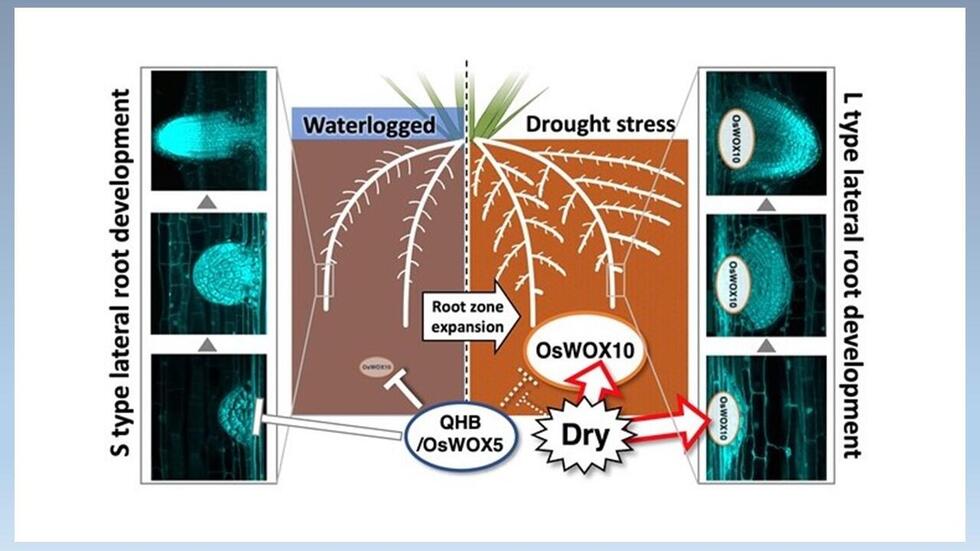
Agricultural sciences
February 25, 2022
The root of it: Understanding molecular basis of lateral root development in rice
Two genes, QHB/OsWOX5 and OsWOX10, have been found to regulate root primordium size and lateral root characteristics in rice.
The ability of rice plants to modify their root systems to adapt to the surrounding soil water conditions is a great example of a phenomenon called phenotype plasticity. However, the exact mechanism behind this remained unknown. Now, an international collaborative team of Japanese, Australian, and Filipino researchers determined the role of two WUSCHEL-related homeobox (WOX) genes in controlling the root primordium size in lateral roots.
Rice plants typically develop two types of lateral roots, which emerge from the primary root: the short and thin S-type; or the long and thicker L-type. The difference in their phenotype endows different abilities: the L-type lateral root system is better suited for water uptake during conditions of drought or osmotic stress. The type of lateral root system depends on their diameter at the root primordium stage (or the root tissue at its earliest stage of development). However, the molecular basis for these differences in primordium size was not known.
In a new study, published in the Proceedings of the National Academy of Sciences, a team of researchers including Tsubasa Kawai, Akira Yamauchi, and Yoshiaki Inukai from Nagoya University attempted to gain a better understanding of the genetic factors influencing the lateral root primordium size in rice. Speaking about the importance of their study, Prof. Yamauchi states, “As the lateral root type determined by its primordium size is an important phenotypic trait for the growth and maintenance of rice plants under variable water environments, our study provides important insights for improving rice plant resilience to environmental stresses through plastic root development.”
The team conducted a series of root tip excision experiments involving the seminal root (a type of embryonic root that is also called the primary root). They found that the root tip excision in a mutant plant with a defect in the gene for S-type roots induced more L-type roots than was observed in the wild type plants. Genetic analysis of this plant revealed that the QHB/OsWOX5 gene to be responsible for this phenomenon.
Further analysis led the researchers to discover that OsWOX10, a gene of the WOX protein family, was being overexpressed in the L-type roots. The researchers determined that OsWOX10’s overexpression increased the diameter of the L-type roots, and mutations in this gene affected the thickness of the L-type lateral roots, indicating its role in mediating L-type root development. Its expression was found to be inversely related to QHB activity, with mutations in QHB resulting in an increased L-type LR in the WT strain.
Based on these results, they concluded that the primordial size of the lateral roots was indeed under the influence of two important genes belonging to the WOX family, QHB and OsWOX10, which were found to have opposing regulatory roles.
Prof. Inukai is hopeful of the potential applications of this discovery, adding, “Improving root phenotypic plasticity is key to better crop production with more efficient water acquisition. Our findings may lead to the development of unprecedented rice varieties with drought stress tolerance and contribute to securing sustainable rice production for growing population in the world.”
Regulatory mechanisms for S type and L type lateral root development in which QHB/OsWOX5 and OsWOX10
play opposing roles in controlling each primordium size in rice. (Credit: Yoshiaki Inukai)
The paper, "WUSCHEL-related homeobox family genes in rice control lateral root primordium size," was published in the journal Proceedings of the National Academy of Sciences on January 4, 2022, at DOI: 10.1073/pnas.2101846119.
Authors:
Tsubasa Kawai*, Kyosuke Shibata, Ryosuke Akahoshi*, Shunsaku Nishiuchi*, Hirokazu Takahashi*, Mikio Nakazono*, Takaaki Kojima*, Misuzu Nosaka-Takahashi, Yutaka Sato, AtsushiToyoda, Nonawin Lucob-Agustin, Mana Kano-Nakata*, Roel R.Suralta, Jonathan M. Niones, Yinglong Chen, Kadambot H. M. Siddique, Akira Yamauchi*, and Yoshiaki Inukai*
* Affiliated to Nagoya University
Contact:
Yoshiaki Inukai
Professor, International Center for Research and Education in Agriculture, Nagoya University
Email: inukaiy@agr.nagoya-u.ac.jp
Funding Information:
This work was supported by the PRESTO program of the Japan Science and Technology Agency (JST) (15H04435), the SATREPS program (JPMJSA1706) of the JST and Japan International Cooperation Agency, and MEXT/JSPS KAKENHI(18H02174, 18J21800).